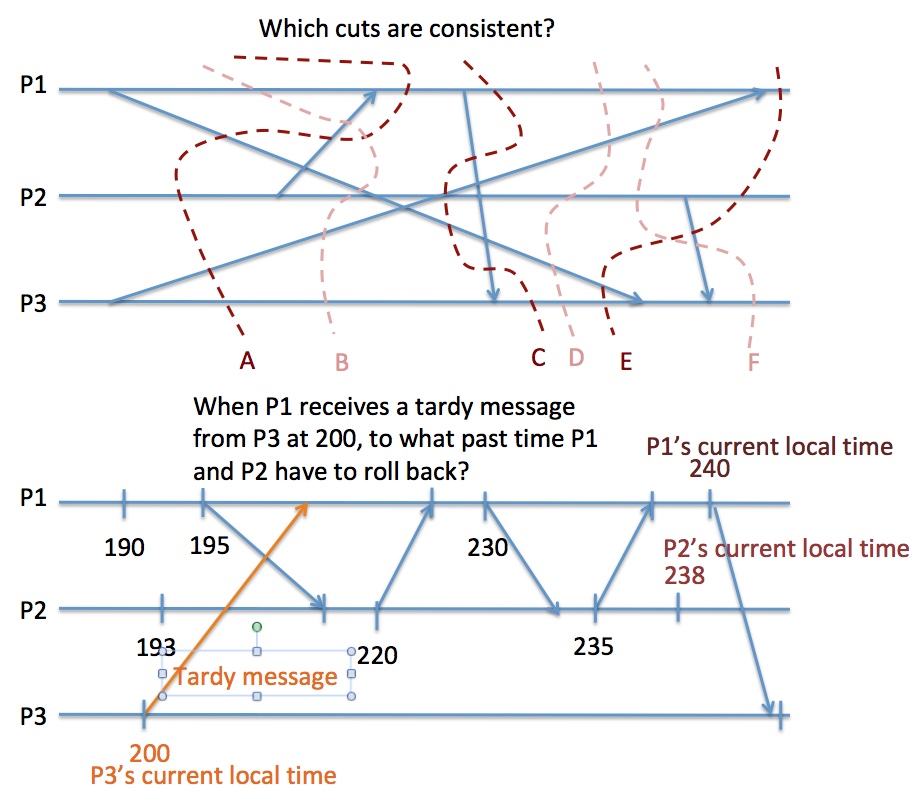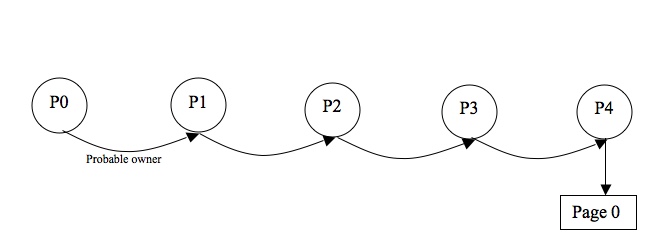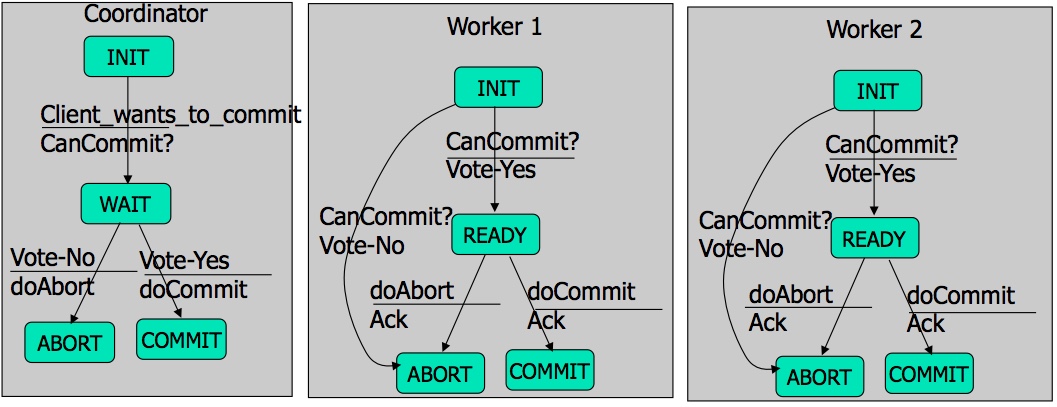| No. |
Discussions |
Grade |
Topics |
| 1 |
Process Migration, Time and Global States |
1% |
- Group 1,6:
- Consider how to move a mobile agent to a remote site and to
resume its execution from a new function there. Where and how do you
think agent execution platforms should use techniques of serialization,
RMI, classloader, and multi-threading?
- Group 2,7:
- Consider three distributed snapshot algorithms such as
Chandy-Lamport's, Samadi's, and Mattern's algorithms. Discuss their
pros and cons.
- Group 3,8:
- An NTP server B receives server A's message at 16:34:23.480
bearing a timestamp 16:34:13.430 and replies to it. A receives the
message at 16:34:15.725, bearing B's timestamp 16:34:25.7. Estimate
the offset between B and A and the accuracy of the estimate.
- Group 4:
- Compare Timewarp and SPEEDS in terms of performance, process
creation/termination, dynamic memory allocation, and I/O handling.
- Group 5:
- Solve the questions in the following charts.

|
| 2 |
Distributed Shared Memory |
1% |
- Group 3:
- Compare Ivy and Dash in terms of considtency models, shared-data
granularity, HW/SW implementation, false sharing, and
implementation. What types of applications can Ivy and Dash benefit
respectively?
- Group 2:
- Group 1:
- Compare distributed shared memory and message passing (such as
MPI) in terms of programmability and performance. Discuss about their
pros and cons using two types of applications: computer graphics such
as 3D ray tracing and spatial simulation such as Heat2D.
- Group 8:
- Group 7, 5:
-
Consider that two processes P0 and P1 are running on a different
computing node, each with its own DRAM memory while they can access
each other's memory through a DSM support. Let's assume that
System.SharedMemory( ) is available to allocate a zero-initialized
shared space. For instance, the following example allocates a 4K-byte
shared space as a byte array.
byte[] byteArray = (byte [])System.SharedMemory( 4096 );
Processes P0 and P1 will execute the following program at the same time.
public class SharedMemory {
public static int main( String args[] ) {
int pid = Integer.parseInt( args[0] ); // args[0] should be 0 or 1 as process ID.
// allocate a 4096-byte zero-initialized shared memory
byte[] byteArray = (byte [])System.SharedMemory( 4096 );
while ( true ) {
if ( ++byteArray[ pid * 32 ] % 100 ) {
// every 100-time increment of byteArray[0] by P0 or byteArray[32] by P1
while ( byteArray[64] != pid ); // wait for my turn
byteArray[64] = ( pid + 1 ) % 2; // then, let the other process go
}
}
}
}
Assume that this DSM is the Dash-like hardware-based multiprocessor
with release consistency whose cache line size is 32bytes (but not
16byes in real Dash). What problem occurs? To address this problem,
how should you change this program?
Group 6, 4:
-
Consider Ivy's ownership manager algorithm. The following figure shows
a given state where process 4 is page 0's actual owner, while other
processes consider their right neighbor as page 0's probable
owner. Now, assume that process 0 reads page 0, and thereafter process
2 reads the same page. Show page 0's new probable owner visible from
each process by drawing new thick arrows.

|
| 3 |
Distributed File Systems |
1% |
- Group 8:
-
Compare NFS (ver 3) and AFS in terms of file-accessing models,
file-sharing semantics, modification propagation (write through or
delayed write), server-side/client-side caching,
client/server-initiated validation, and stateful/stateless server.
- Group 7:
- Discuss about the pros and cons of backward transaction and
forward transaction.
- State the pros and cons of server-side caching. Also, state the
pros and cons of client-side caching.
- Group 6, 5:
- Consider two extreme cases when using PVFS. Case 1 is to let an
MPI program read many small files. Case 2 is to let an MPI program
read a single large file
- Group 4, 3:
- Given the following code, implement a client-initiated
invalidation in FileClient.java. Note that the client can cache only
one file. Assume that FileServer.java has been already implemented.
public class FileContents implements Serializable {
private byte[] contents;
private Date time;
public FileContents( byte[] contents ) {
this.contents = contents;
}
public byte[] get( ) {
return contents;
}
public Date timestamp( ) { // the timestampe when downloaded from the server
return time;
}
}
public interface ServerInterface extends Remote {
// download a given file from the server
public FileContents download( String filename ) throws RemoteException;
// upload a given file's contents to the server
public boolean upload( String filename, FileContents contents ) throws RemoteException;
// check the timestampe of a given file
public Date timestamp( String filename ) throws RemoteException;
}
public interface ClientInterface extends Remote {
// invalidate the client cache
public void invalidate( ) throws RemoteException;
public FileContents writeback( ) throws RemoteException;
}
public class FileClient extends UnicastRemoteObject implements ClientInterface {
private String cachedFilename = null; // the name of the file cached at the client
private FileContents fileContents = null; // the file contents cached at the client
private String cachedFileStatus = null; // "r" or "w"
public static void main( String[] args ) throws RemoteException {
new FileClient( args );
}
public FileClient ( String[] args ) throws RemoteException {
try {
Scanner input = new Scanner( System.in ); // keyboard input
ServerInterface server // access a file server
= ( ServerInterface )
Naming.lookup( "rmi://" + args[0] + ":" + args[1] + "fileserver" );
while ( true ) {
System.out.print( "FileClient: file [r/w]: " );
String filename = input.next( ); // read a file name to operate
String r_w = input.next( ); // check the read/write mode of this file
// Client-initiated file validation before accessing a file
if ( cachedFilename != null ) { // some file cached at the client
if ( !filename.equals( cachedFilename ) ) { // need a different file
if ( cachedFileStatus.equals( "w" ) ) { // the client wants to write
// ITEM 4 and 5:
// Write the current cached file back to the server before downloading a differen file
// Implement it (Both CLIENT and SERVER-INVALIDATION)
}
}
// ITEM 4: CLIENT-INITIATED INVALIDATION
// Need to check the timestamp here, right?
}
else // no file is cached at the client
fileContents = server.download( filename );
// start a text editor to open the file.
cachedFilename = filename;
cachedFileStatus = r_w;
runTextEditor( fileContents, cachedFileStatus );
}
} catch ( Exception e ) {
}
}
public void invalidate( ) {
// ITEM 5: SERVER-INITIATED INVALIDATION
// Implement it
}
public FileContents writeback( ) {
// ITEM 5: SERVER-INITIATED INVALIDATION
// Implement it
}
private void runTextEditor( FileContents file, String r_w ) {
// assume that it has been already implemented
}
}
- Group 2, 1:
- Given the above code, implement a server-initiated invalidation
in FileClient.java. Note that the client can cache only one
file. Assume that FileServer.java has been already implemented.
|
| 4 |
Fault Tolerane |
1% |
- Group 1, 5:
- Discuss about Gossip and Coda:
- Could the gossip architecture be used for a distributed computer
game as described below? The players move figures around a common
scene. The state of the game is replicated at the players'
workstations and at a server, which contains services controlling the
game overall, such as collision detection. Updates are multicast to
all replicas.
- The quorum-based replication protocol can address network
partition problems. Why didn't Code use this protocol? Explain the
reason.
- To cope with the network partition problem, what featreus does
Coda have?
- Group 2, 6:
- The following state transition diagram describes the two-phase
commitment protocol. Let's assume that worker1 crashed when a
coordinator sent a doCommit message. Trace this diagram. To be
specific, make appropriate arrows "thick, read arrows" with your pen
or pencil.

- When worker1 gets resumed back, what does it have to do?
- Group 3, 7:
- Discuss about Hadoop (HDFS)
- Consider why HDFS maintains only one primary and only one
secondary name server? Why not multiple name nodes?
- Explain how HDFS maintain replicas.
- On top of HDFS, a MpaReduce program can run in parallel. For
fault tolerance, how does MapReduce rerun a crashed job?
- Group 4, 8:
- The following MPI program wants to checkpoint each rank's
computation as a snapshot every for-loop iteration, anticipating any
crash in the middle of an entire computation. When being resumed from
a crash, this MPI program wants to resume the on-going computation
from the latest snapshot rather than redo from the scratch. Consider
checkpoint( ) and resume( ) you find at the bottom of this code and
implement them as accurate as possible.
import mpi.*;
public class FT_MPI {
private static int rank = 0;
private static int size = 0;
private static int[] data = new int[1];
private static int i;
public static void main( String[] args ) throws MPIException {
MPI.Init( args );
rank = MPI.COMM_WORLD.Rank( );
size = MPI.COMM_WORLD.Size( );
data[0] = 0;
resume( );
for ( i = 0; i < 1000000; i++ ) {
// communication from the left neighbor
if ( rank > 0 )
MPI.COMM_WORLD.Recv( data, 0, 1, MPI.INT, rank - 1, 0 );
// do some dummy computation
data[0] += rank + 1;
if ( rank < size - 1 )
MPI.COMM_WORLD.Send( data, 0, 1, MPI.INT, rank + 1, 0 );
// communication to the right neighbor
if ( rank == size - 1 )
System.out.println( data[0] );
checkpoint( );
}
MPI.Finalize( );
}
private static void checkpoint( ) {
// any arguments?
// what data to save into a snapshot file
}
private static void resume( ) {
// any arguments?
// what data to resume from a snapshot file
}
}
|


